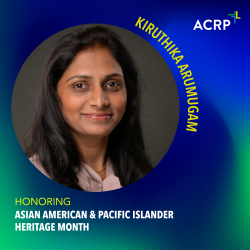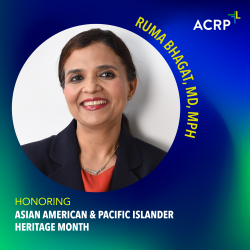Activating more clinical trials that will successfully deliver new and improved drugs and medical devices to the public demands a modern clinical research workforce whose employers and other stakeholders can no longer afford to wait for newcomers to simply “fall into it” by chance, members of a panel of experts told attendees at ACRP 2024 in Anaheim, Calif. this morning (May 4).
Some of the other educational sessions from the Saturday morning lineup of topics concentrated on the intricacies of pitching the availability of clinical trials to potential participants, and on incorporating the principles of best patient engagement practices into the training of clinical research professionals.
Sharing lessons learned in a Signature Series session on “The Innovators in Action: Novel Programs Addressing Workforce and Enrollment Issues” were Lora Black, RN, MPH, Executive Director, Clinical Research—Sanford Research, Sanford Health; Kelly Clark, BScN, MSHS, Head of U.S. Partnerships and Global Site Development, Merck; Michaele Linden Johnson, FACHE, MBA, Senior Director of Clinical Trials and Business Development, Medical Center of the Americas Foundation; Sandra Smith, RN, MSN, AOCN, Senior Vice President, Clinical Solutions and Strategic Partnering, WCG; and Leslie Wolfe, BS, MHA, Director, Clinical Research—Early Talent Development, Merck. The panel was moderated by Denise Snyder, MS, RD, LDN, Associate Dean for Clinical Research, Duke University School of Medicine.
“We haven’t seen trends [in staffing recruitment and retention at sites] improve over the past few years,” Smith said, adding that a 2023 WCG survey of study sites found that 63% of respondents considered staffing their biggest challenge. “Measuring and finding out what works best [to address site challenges] is incredibly important.”
Noting that Merck has been seeing an increase in the number of trials that the sites-based workforce could not keep up with, Wolfe said the company’s Early Talent Development program is reaching out to schools “to plant the seeds of interest” in the clinical research field. Further, instead of continuing to hire only experienced individuals, Merck decided to “create our own workforce from within,” partially through hiring graduates of its summer internship experience into the Early Talent Development program, which required a “huge mind shift” in the organization, with modified job descriptions and onboarding practices.
Operating in a largely rural area including the Dakotas, where the pandemic “wiped out” much of the clinical research coordinator (CRC) workforce, Sanford Health realized “we’ve got to do something different,” so it developed its own online CRC certificate program to educate and recruit new talent for its sites, according to Black. “It’s very rare that people say ‘I want to be a clinical research coordinator,’” Black said, but with a nine-to-12-month training regimen involving ACRP Competency Domains for Clinical Research Professionals, the organization is building a strong workforce equipped with “the nuts and bolts of how to be a coordinator.”
With the Medical Center of the Americas Foundation dedicated to growing the life sciences industry in West Texas, Johnson concentrates on developing clinical research infrastructure, including being “a broker” in site expansion efforts and fostering entry-level CRC training for students who can gain paid experience at participating sites. “If we’re going to tackle 21st-century workforce challenges…we can’t just do what we used to do and expect different results,” she said.
Noting that “we have to be very intentional about how we fuel that [workforce] pipeline,” Clark added that “we can really no longer just hope that people will just wander into the workforce” and make everything better. She said that Merck is delivering ACRP-developed training to early talent coordinators at sites in the fundamentals of being a CRC.
In their session on “Engaging Hearts and Minds: Making an Irresistible Pitch in Patient Recruitment,” Krista Ellis, MS, CCRC, a Project Manager at the University of Utah, and Brooklyn Henderson, RN, ACRP-CP, a Research Services Consultant at Vanderbilt University Medical Center, looked at how to convert disinterested, but otherwise eligible, patients into study participants.
Having examined recruitment results for a variety of study types and patient populations, Henderson said they found that anywhere from 10% to 60% of potential participants “just say ‘I’m not interested.’” This begs the question, she added, that if clinical research professionals respect a patient’s right to say no to a study, as they should, “What can we do differently in terms of how we approach our patients and approach our study?”
Ellis stressed the importance of taking the time to create a “genuine human connection” with patients who are being introduced to the idea of enrolling in a trial, otherwise the entire informed consent process may fall apart within the first few minutes. “If we communicate our ‘why’ for [conducting] research” and include asking their reason why they might participate in a trial among best practices for patient engagement, she added, “we can [more effectively] attract people to our studies.”
Meanwhile, former Chair of the ACRP Board of Trustees Erika Stevens, MA, FACRP, Director of Clinical Research Experience and Faculty Lecturer for the MS in Clinical Research Management track at Rutgers Health, and Bridget Strong-Benson, PhDc, MBA, CCRP, Associate Executive Director for Clinical Research Education and Quality Improvement in the Office of Clinical Research at Emory University, focused on “Incorporating Patient Engagement in the Training of Clinical Research Professionals.” Among other issues raised, they connected patient engagement principles to various elements of the Joint Task Force Core Competency Framework for Clinical Research Professionals.
“Clinical trials continue to be complex, even for those of us who have been involved in them for many years,” Stevens noted, and not just in terms of “how do we involve the patients, but how do we prepare the professionals to engage them.”
For more in-depth exposure to the concepts the speakers tackled in their presentation, Strong-Benson recommended attendees access the Research Community Forums of the Office for Human Research Protections and the Multi-Regional Clinical Trials webinar series on “Returning Individual Research Results and Data: Digging Deeper,” among other resources.
Author: Gary Cramer



